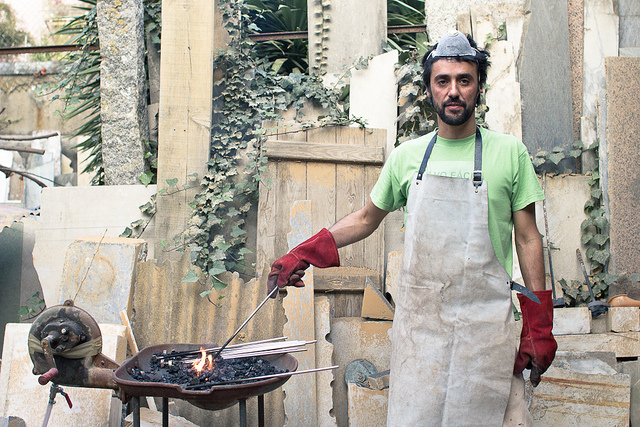wanderlust
Would You Like Your Art Well Done?

A shirt, a gun, a helmet: Isaque Pinheiro’s works of art may seem like pretty cool ready-mades – ordinary, found objects modified by an artist. But labels can be a tricky and an artwork may not be what it looks like. In my talk with Pinheiro, I come to realize one of the things I like the most about art: its ability to always be ready to prove us wrong.
Not What It Looks Like
“I even make jokes with my friends about this subject: No, no, no, I do not work with ready-mades—I make ready-mades by myself!” Born in Lisbon, Portugal but based in Porto since the 90s, Pinheiro explains the concept behind his work: “I think it's the opposite of the ready-made because I make it with other materials. They are recreations of objects.”

This means that you won’t find Pinheiro’s work on the shop next door; whenever an object is presented in his work, it has been handmade by the artist. “I think that, deep down, I don’t have any ready-mades in my body of work. What characterizes a ready-made is to pick an object and simply de-contextualize and conceptualize a bit around it, put in a gallery space and elect this object as a work of art. And I guess I never did that. I made representations of objects. But then it leads us to the story of ceci n'est pas une pipe. I never had the pipe in an exhibition. I always had representations of the pipe,” he reflects.
Inspirational Agenda
Self-taught, Isaque Pinheiro always knew he wanted to be an artist (a painter, at first). Yet his current work is far from being made out of canvases and brushes. His studio, where he creates his vast sculptures, resembles a workshop – not only because of its appearance but also due to its workflow. Pinheiro tells me that each of his projects demands months of dedication, so it is important to choose the best ideas to work on and then organize a production schedule – something that needs to be planned step-by-step, as he sometimes needs to hire outsourced services and even assistants.
This planning doesn’t affect only the physical sphere, though. Because we're talking about an artist and not an industry, Pinheiro tells me about the importance of organizing his thoughts. How does a material become a piece of art? In which part of this huge production does the work start to have a meaning? “I have many ideas daily. Usually they do not have a context, a concept or an intellectual part. But I keep all these ideas and then, when I figure a context, I say ‘Wait a minute, I have this idea that I did not have the guts to do because it was absurd or because it didn’t have any context.’ Quite often I start to work on ideas that I had six years before.”
Fortunately, Pinheiro has a much better memory than I do. In his creative process, he has developed a scheme that helps him decide what is the best idea to bring to reality: “I make notes. And I think that's great because they will mature. I write almost everything down but rarely check them. Almost never. So this is the filter: whether I’ll forget the idea or not.”
As we near the end of our conversation, he shares, “I hardly remember having an abstract piece.” The same way he organizes and schedules his production, he has some plans for the development of his artistic concept: “Maybe I'm still in the first phase of my work – the abstraction is something that I still can’t reach but I think one day I'll get there. I give so much importance to it that I can’t go to this level in an irresponsible way. I do not feel comfortable falling into meaningless abstraction, being completely lost. It is natural that one day I’ll go towards this direction in my work. What has not happened yet.”
Isaque Pinheiro is represented by Caroline Pages Gallery [Price range of works: 2,000 – 25,000 Euros]
Article by Bel Borst
Be the first to write a comment.
Your feedback




